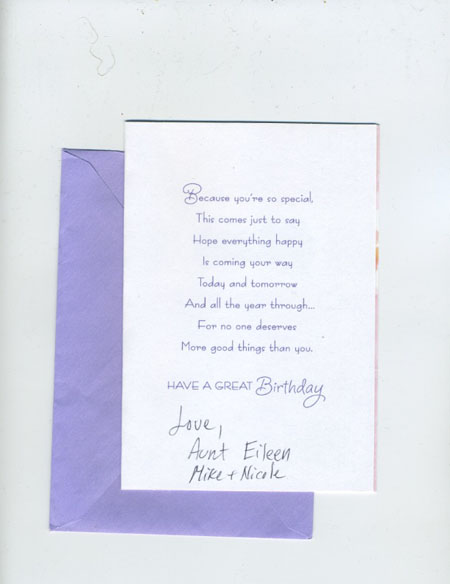![]() body | color | collections | commodity | cube | document | fabric | fetish | gender | glass | home | identity | living | machine | metal | minimal | mobility | narrative | olfactory | organic |
body | color | collections | commodity | cube | document | fabric | fetish | gender | glass | home | identity | living | machine | metal | minimal | mobility | narrative | olfactory | organic |
![]() pain | paper | plastic | plugs | power | protective | rectangular | ritual | round | sound | souvenir | spiritual | style | text-based | time | tool | touch | uniform | value | visual | warm | wood
pain | paper | plastic | plugs | power | protective | rectangular | ritual | round | sound | souvenir | spiritual | style | text-based | time | tool | touch | uniform | value | visual | warm | wood
| Birthday Card | |||
Narrative: This card was given to me on my birthday in 2008 from my cousins, aunt, and uncle. Hallmark cards are made in the U.S.A. The points of most ballpoint pens are made out of brass, which is an alloy of copper and zinc. Oleic acid, castor oil, or a sulfonamide plasticizer are also used. The markers bodies, caps, and plugs are formed from plastic resin. The marker reservoirs are formed from polyester. Powder and water are used to form the felt writing tip. In addition, markers require ink, and the pigments and synthetic substances used to make it. To make the body of the marker, plastic resin is injection-molded into a marker body. Injection molding involves heating plastic resin, into a molten state and forcing (injecting) it into a mold of the desired shape, then allowing it to cool and harden. Marker caps and plugs are formed in the same manner as the barrel. The nib, or tip, of the marker is made from powder mixed with water, molded, and baked into its pointed or flat form. Using one machine for all the following functions, an assembler then places a polyester cylinder inside the marker barrel to form a reservoir for the ink, fills the reservoir with ink, and inserts the nib at the bottom and the cap at the top. The markers are then placed into color assortment and packaged for retail marketing. Rolls of paper, typically weighing 220 lb are either cut before they enter the automated machine that makes the envelopes, or fed directly into the machine from the roll. Once cut, the sheets are stacked and cut into blanks. A blank has the shape of an envelope with its flaps opened and laid flat. Shaped like diamonds and cut from the sheets in such a way as to minimize waste. The glue applied to the flap that is sealed by the consumer is usually a gum. A typical natural gum is gum arabic, derived from a substance produced by the acacia tree. Synthetic gums are often derived from dextrans, which are produced by the fermentation of sugar. The glue that holds the rest of the envelope must be stronger and more permanent. This glue is often derived from starches, which are obtained from corn, wheat, potatoes, rice, and other plants. The completed envelopes are filled in cardboard boxes and shipped to retailers. Layered paper is produced by putting a number of sheets of paper in a stack and gluing them together. Using a photographic process a negative of the image is exposed to a flat plate and coated with a light sensitive material. The plate is developed, and the image area is coated with an oily material that will attract ink but repel water. The non-image area is coated. One plate per color is created. The plate is passed under a roller on the printing press, which coats it with water. The image area on the plate, previously treated with the oily material, repels the water and remains uncoated. An ink roller is next passed over the plate. A rubber roller is then passed over the printing plate and the ink from the plate is transferred to it. The card paper is passed under the rubber roller and the ink is transferred to it. This is done in color order. The ink dries before it enters the next roller assembly. This process of wetting, inking, and printing is continuous throughout the card manufacturing run. After both sides of the pasteboards are printed, they are transported to a card cutting station. Precision-cutting machines cut the cards out from the printed sheets. |
 |
||
![]()
